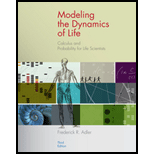
Concept explainers
To find: The long term dynamic in each of the cases and find one that will beat other every time and displays 2:1 AV block and which show some sort of Wenckebach phenomenon.
Answer to Problem 19E
The inequality
is not satisfied and it is not the case of the wenchback behaviour of 2:1 AV block nor the Wenckebach phenomenon bears a behaviour that is random in nature and means the heart beat not follow a sequence but it beats the random way that is in accordance to the signal by the AV node from the SA mode.
Explanation of Solution
Given:
The parameters are,
Calculation:
The potential of the AV node
Then,
For
The equilibrium exits only if the heart is indeed ready to beat when the next signal comes as,
Thus, the equilibrium exists only if
For
This gives
Now set
The equilibrium exits only if the heart is indeed ready to beat when the next signal comes, that is,
The above equation is,
Thus, the equilibrium exists only if
The updated potential after two cycles matches the original potential if
Then, the solution has,
The dynamic through the complete cycle finding is,
Since, the inequality
The equation for the equilibrium.
The requirement that
From the values of
The inequality is not satisfied as
Consider the value of
Set the value of
The equilibrium exists only when the heart is ready to beat at the arrival time of the new signal arrives or if,
The equilibrium is there only if
The value of the potential after these two cycles come back exactly to where it started, thus the heart beat with the potential with every signal producing 2:1 AV block.
The updated potential after two cycles matches the original potential of
Thus, the solution is,
The equation for the equilibrium is,
Thus, the inequality
is not satisfied and it is not the case of the wenchback behaviour of 2:1 AV block nor the Wenckebach phenomenon bears a behaviour that is random in nature and means the heart beat not follow a sequence but it beats the random way that is in accordance to the signal by the AV node from the SA mode.
Want to see more full solutions like this?
Chapter 1 Solutions
Modeling the Dynamics of Life: Calculus and Probability for Life Scientists
 Linear Algebra: A Modern IntroductionAlgebraISBN:9781285463247Author:David PoolePublisher:Cengage Learning
Linear Algebra: A Modern IntroductionAlgebraISBN:9781285463247Author:David PoolePublisher:Cengage Learning Trigonometry (MindTap Course List)TrigonometryISBN:9781337278461Author:Ron LarsonPublisher:Cengage Learning
Trigonometry (MindTap Course List)TrigonometryISBN:9781337278461Author:Ron LarsonPublisher:Cengage Learning

